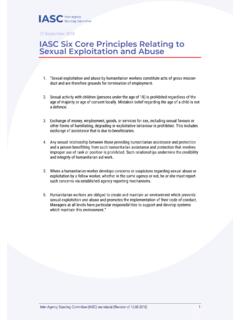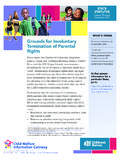Transcription of The Impact of Child Maltreatment on the Educational and ...
1 The Impact of Child Maltreatment on the Educational and Psychological Well-Being of Students Jonathan Chitiyo University of Pittsburgh at Bradford Zachary Pietrantoni California State University at East Bay 2. Abstract Child Maltreatment continues to be a major health and social welfare problem across the globe. In the United States, millions of children from all socioeconomic backgrounds, across all ages, religions, and cultures are victims of Child Maltreatment every day and millions more are at risk. Research has consistently shown that exposure to Child Maltreatment in all its forms negatively affects the current and future Educational performance and emotional and psychological well-being of children. The purpose of this paper is to provide a literature synthesis of the Impact of Child Maltreatment on the Educational and psychological well-being of students.
2 Recommendations for educators working in school settings are provided. Keywords: Child Maltreatment , education, students with disabilities 3. The Impact of Child Maltreatment on the Educational and Psychological Well-Being of Students The problems of Child Maltreatment have been extensively documented in the literature over the past two decades. According to the Children's Defense Fund (CDF;. 2014) and the Department of Health and Human Services ([HHS], 2012, 2017), millions of children worldwide from all socioeconomic backgrounds, across all ages, religions and cultures are exposed to Child Maltreatment every day and millions more are at risk. Child - Maltreatment is an umbrella term that includes abuse and neglect of children (McCoy & Keen, 2013; Gilbert et al., 2009). Broadly defined, Child abuse is when a parent, a primary caregiver, or any other person who has responsibility for the Child through an action ( , beating, stabbing).
3 Causes injury, death, emotional harm, or risk of serious harm to a Child . Child abuse can take many forms including physical abuse , sexual abuse , exploitation , and emotional abuse (Altafim & Linhares, 2016). Existing research indicates that emotional abuse is the most common form of abuse (Foster, Olson-Dorff, Reiland, & Budzak-Garza, 2017). with physical abuse being the most reported (Tillman et al., 2015) and sexual abuse being the least reported (Foster et al., 2017). Conversely, Child neglect is defined as the failure of a parent, guardian, or other caregiver to provide for a Child 's basic needs ( , physical, medical, Educational , and emotional needs). According to Foster et al. (2017), Child neglect is often underreported but has devastating effects on children. Child Maltreatment consists of Child abuse and Child neglect. Usakli (2012) noted that Child Maltreatment occurs across socio-economic, religious, cultural, racial, and ethnic groups (p.)
4 116). It is estimated that approximately 80% of Child Maltreatment is 4. perpetrated by parents or primary caregivers, except for sexual abuse which in most cases is perpetrated by acquaintances or other relatives (Crosson-Tower, 2003; Gilbert et al., 2009). In the United States, Child Maltreatment is regarded as one of the country's' most serious problems as it is responsible for substantial morbidity and mortality of young children (Fang, Brown, & Florence, 2012; HHS, 2017). In 2015, national, state, and local Child protective services (CPS) offices received four million referrals involving approximately million children who were subjects of abuse or neglect (HHS, 2017). Of that number, it is estimated that 683,000 children died. However, it is important to note that some researchers argue that the CPS data underestimates the actual number of children who are victims of Child Maltreatment (Fang et al.
5 , 2012). This suggests that the number of children who are victims of Child Maltreatment might be more than reported (Everson et al., 2008; MacMillan, Jamieson, & Walsh, 2003). Existing research indicates that young children are the most vulnerable to Maltreatment because they may be heavily dependent on caretakers (Fang et al., 2012). Data from the HHS (2017) revealed that more than one quarter of victims of Child Maltreatment were below the age of three. In addition, it has been found that girls are more likely to be victims of certain forms of Maltreatment ( , sexual abuse ) than boys whereas boys are more likely to be victims of physical abuse (HHS, 2008; Andrews, Corry, Slade, Issakidis, & Swanston, 2004). Finally, research also indicates that children with disabilities (especially those with severe disabilities) may also be more vulnerable to Maltreatment than children without disabilities (Sullivan, 2003; Sullivan & Knutson, 5.
6 2000). It is possible that some children with disabilities may have limited communication skills and this makes it difficult for them to understand and verbalize episodes of abuse . Research on the prevalence of Child Maltreatment is especially problematic when school personnel are underprepared to address reports and suspected cases. Teachers are usually the first school personnel to suspect cases of Child Maltreatment , and school counselors are usually the school personnel who most often make the reports (Altafim &. Linhares, 2016). In 2012, Usakli conducted a survey with teachers and school counselors and found that both reported feeling unprepared to address Child Maltreatment issues at school. Teachers reported being aware of the effects of Maltreatment but felt unprepared in how to identify, report, and intervene (Usakli, 2012). Moreover, Usakli (2012) found that school counselors did not feel adequately prepared to help support the Child and family.
7 School counselors reported that they need information on the basic facts related to the subject matter, identification criteria, how they should act when they are intervening, how they should approach the student, how they should save the student, and information on the legal aspects of the program (p. 121). Effects of Child Maltreatment Factors that contribute to Child Maltreatment are extensively documented in the literature with some studies citing parental stress and parental health as the main predictors of Child Maltreatment (Crouch & Behl, 2001; Nair, Schuler, Black, Kettinger, &. Harringhton, 2003). Other studies have shown that beliefs related to parenting ( , belief in the value of corporal punishment) are also related to risk of Child Maltreatment (Milner, 2000). Altafim and Linhares (2016) found that parents who experience high- 6.
8 Levels or chronic-levels of stress or experience sudden shifts on attitudes about discipline are also risk factors associated with Child Maltreatment . It has also been found that most Child Maltreatment cases involve parents or guardians who abuse drugs (HHS, 1999). A survey by the National Center on Child abuse Prevention Research (2001) found that 85% of the states in the reported drug and substance abuse as one of the common problems in households where Child Maltreatment is suspected. Child Maltreatment in all its forms has significant negative impacts on the development, current and future Educational performance, and emotional and psychological well-being of children (Crozier & Barth, 2005; Foster, et al., 2017; Usakli, 2012). In addition, experiences of childhood Maltreatment can have detrimental implications in adulthood ( , emotional distress and risky sexual behavior, which increases vulnerability to sexually transmitted diseases (Currie & Widom, 2010; Pepin &.))
9 Banyard, 2006). Psychological Well-Being of Children As previously discussed, Child Maltreatment is a universal problem and one that can have negative long-lasting effects on the psychological well-being of children (Altafim & Linhares, 2016; Usakli, 2012). Since Child Maltreatment is usually perpetrated by parents/primary caregivers or other close family members, children are often left with no one to turn to and they can experience traumatization as they might lack social and emotional support to cope with such situations. Several large-scale studies have reported that children subjected to Maltreatment may suffer from depression, anxiety, stress related disorders, and post-traumatic disorders (Lambie, 2005; Tillman et al., 2015; Usakli, 2012). For example, a study by 7. Widom (1999) showed that children (n = 1196) who were maltreated before the age of 12 and assessed at age 29 had a post-traumatic disorder diagnosis.
10 Such a diagnosis can have devastating effects on an individual. Existing research shows that that individuals with a post-traumatic disorder are more likely to commit suicide (Gilbert et al., 2009), and more likely to have alcohol and drug problems (Widom, Weiler, & Cottler, 1999). It has also been reported that Maltreatment is associated with eating disorders ( , bulimia and anorexia) and self-injurious behaviors ( , hair pulling, breaking bones, head banging) and some of these behaviors can be life threatening (Ericsson et al., 2010; Tillman et al., 2015). However, it is important to note that the psychological effects of Maltreatment on a Child 's well-being may manifest differently for each Child depending on the form of abuse . Research has found that depression and other stress related disorders are more likely to be associated with neglect and physical abuse (Gilbert et al.)











